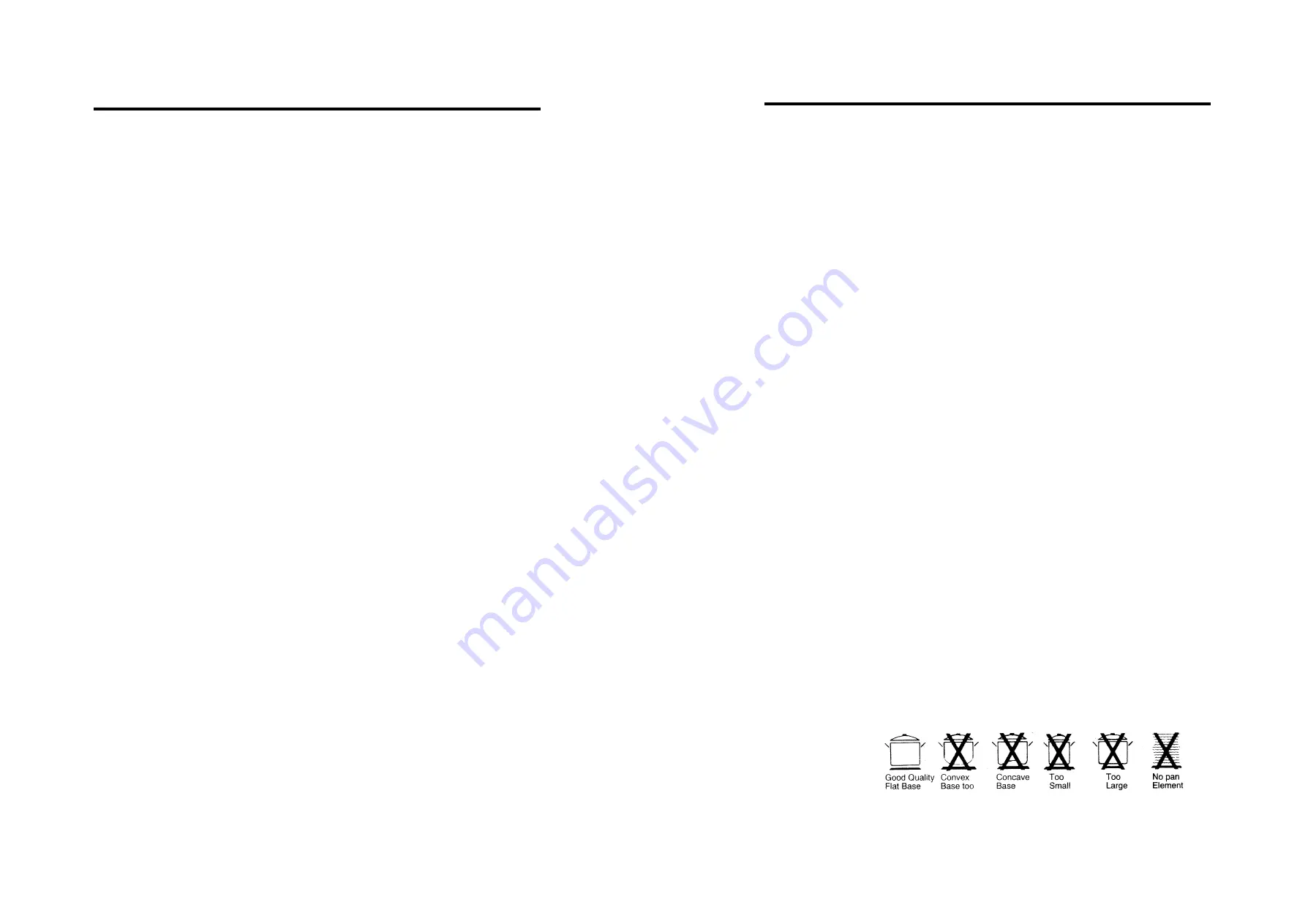
10
Using A Ceramic Hob - Safety
WARNING!
If any crack should appear on the hob, isolate the hob
immediately from the mains supply. Do not use any part of the
hob but contact your Belling Service Agent.
The ceramic hob elements are fitted with special controls to
regulate the element temperatures and to prevent overheating. The
elements will be seen to switch on and off during use as the
temperature is maintained automatically. This cycling effect is
perfectly normal, and is part of the designed operation of the
elements and controls. A slight hum may be heard from the
elements while they are in use.
Although the heating elements are fitted with safety cut-outs to
prevent overheating, it is important that the elements are not
operated for any length of time without a pan on the hob, as
overheating can still occur and may cause damage.
Whilst it is recommended that normal cleaning is carried out when
the hob has cooled, if jam, fruit or anything with a high sugar
content is spilled on the hob, or plastic or aluminium is melted onto
the hob, clean it off immediately, as damage to the hob can result.
(See ‘Care of your hob’ on page 16)
Safety requirements IMPORTANT –
As with any cooking appliance there could be some
for deep fat frying
fire risk attached to the heating of oil, particularly for deep fat frying,
cooking utensils containing oil
must not be left unattended
(eg. to
answer the telephone) on or in close proximity to the cooking
zones. To minimise the risks inherent with deep fat frying, we
recommend the following;
1.
Use a deep pan, large enough to completely cover the
appropriate heating area.
2.
Never fill the pan more than one-third full of fat or oil.
3.
Never leave oil or fat unattended during the heating or
cooking period.
4.
Do not try to fry too much food at a time, especially frozen
food.
This only lowers the temperature of the oil or fat too much,
resulting in greasy food.
5.
Always dry food thoroughly before frying, and lower it
slowly into the hot oil or fat. Frozen foods, in particular, will
cause frothing and spitting, if added too quickly.
6.
Never heat fat, or fry, with a lid on the pan.
7.
Keep the outside of the pan, clean and free from streaks of
oil or fat.
In the unfortunate
1.
Switch
Off
the electricity supply.
event of a chip
2.
Smother flames with a fire blanket or damp cloth. Only if .
pan fire
safe to do so.
3.
Leave the pan to cool for at least 60 minutes before
moving.
If you cannot control the fire, close the kitchen door,
evacuate the house and call the fire brigade. Do not go
back into the house until you have been told it is safe to do
so. Burns and injuries are almost invariably caused by
picking up the burning pan and rushing outside with it.
11
Using A Ceramic Hob – General Information
NEVER
Never
cook directly on the hob surface without a cooking utensil as
this will result in damage to the surface of the hob.
Never
use the hob as a worktop surface as damage may occur to
the smooth sides of the hob.
Never
drag or slide utensils on the hob surface, as this will cause
scratches in the surface of the hob.
Never
place anything between the base of the utensil and the
ceramic hob, e.g. do not use asbestos mats, aluminium or wok
stands.
Never
leave any utensils, food or combustible items on the hob
when it is not in use.
Never
place aluminium or plastic foil, or plastic containers on the
hob.
Never
leave the hotplates or cooking areas switched ON unless
they are being used.
We recommend not to place large preserving pans or fish kettles
across two heated areas.
Never
leave utensils partly covering the heated areas. Always
ensure that they are placed centrally over the heated areas and
have the same diameter as the heated area used.
We recommend not to use a utensil with a base diameter greater
than 25cm (10”).
ALWAYS
Always
use good quality smooth flat based utensils.
Always
use a utensil which has approximately the same base area
as the heating area zone being used.
Always
use utensils which have more than sufficient capacity for
the amount of food being cooked to prevent boil over or spillage.
Always
use utensils with good fitting lids.
Always
use a low dome pressure cooker for best results.
saucepans with smooth flat bases. Aluminium pans with coloured
vitreous enamelled bases absorb heat and are therefore more
efficient in use. Almost equally as good are saucepans with a thick
machined aluminium base. If using enamelled steel or cast iron
pans, ensure that they have good
smooth flat bases as otherwise the heat will not be distributed
evenly and damaging heat spots may be created.
Never
use recessed or ridged base utensils. Ideally the base of
saucepan should be approximately the same size as the heating
area, up to a maximum of 254mm (10").




























